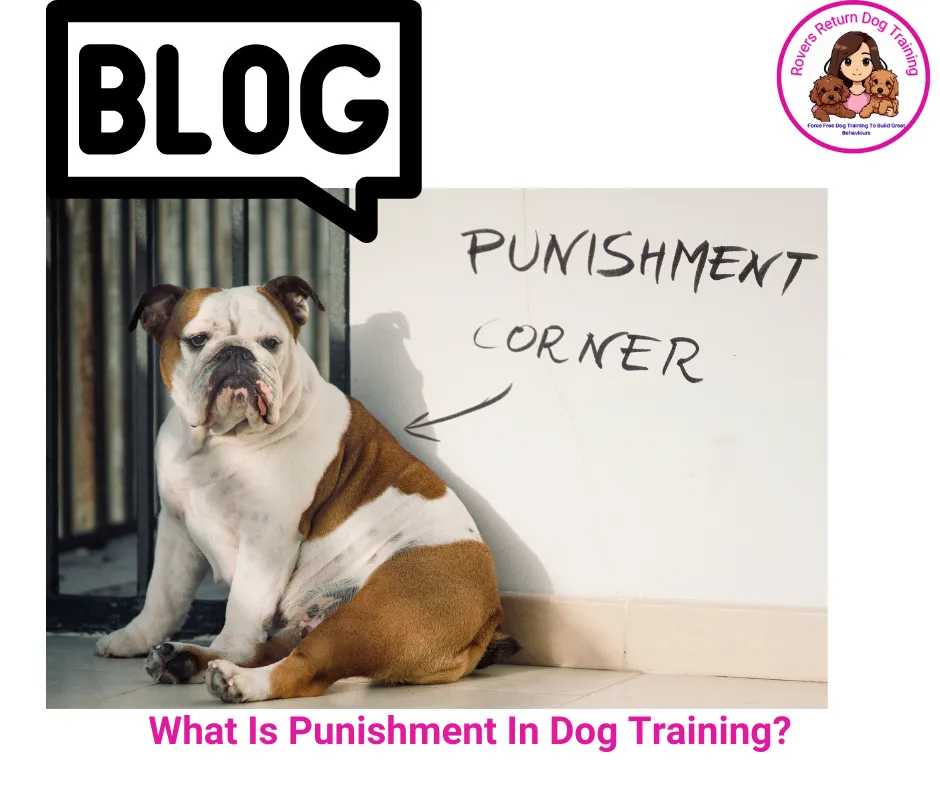Book a FREE 1:1 Assessment Call By Clicking HERE
Specialising In Dog Reactive Behviour
Accredited by APDT, ABTC and UK DOG Behaviour and Training Charter
Qualified and Experienced
Force Free Trainer and Behaviourist
Dog Training Leicestershire Educational Blogs

What Is Punishment In Dog Training?
Whenever we are punished, more and more elements of our environment become negative reinforcers and punishers. We come more and more under coercive control and we rely more and more on counter coercion to keep ourselves afloat. That is why conditioned punishment is a “toxic” side effect of punishment. Environments where we are punished become punishing themselves and we react to them as natural punishers. (Sidman, 1989/2000.”

Why You Shouldn't Use Punishment To Train Your Dogs
Introduction:
The Problem with Punishment: A "Toxic" Side Effect
Training with your dog can be one of the most rewarding experiences for both you and your dog. However, your chosen methods can significantly impact your dog's behaviour, well-being, and relationship with them. One approach that experts and animal behaviourists strongly advise against is using punishment.
You might hear arguments that punishment "works quickly." And yes, it can suppress a behaviour at the moment because, as living beings, dogs (like us) are hardwired to avoid pain and discomfort for survival. The brain’s immediate priority is self-preservation.
There have been a lot of heated debates about which method of training is the most effective.
However, this "quick fix" comes at a steep, hidden cost. As renowned behaviourist Murray Sidman (1989/2000) eloquently stated:
"Whenever we are punished, more and more elements of our environment become negative reinforcers and punishers. We come more and more under coercive control and we rely more and more on counter coercion to keep ourselves afloat. That is why conditioned punishment is a 'toxic' side effect of punishment. Environments where we are punished become punishing themselves and we react to them as natural punishers."
This article seeks to address what punishment is and explain why you should not use it when training your dog.
How To Start Training My Dog.
Positive reinforcement training is the most effective method of dog training. But understanding how your dog learns and how different training methods affect your dogs behaviour is the first step to effectively train your dog.
A dog has essential needs that should be met for them live a happy life. The Hierachy Of Dogs Needs depicts the standard of care that should be given to all animals.

The science of learning has been studied for over a hundred years. The studies are still used today when teaching psychology for humans and animals.
In 1905 Edward Thorndyke studied and published the law of effect.
The law of effect states that
‘Responses that produce a satisfying effect in a particular situation become more likely to occur again in a similar situation. Responses that create a negative effect become less likely to be repeated in similar situations.
The basis of survival is to seek what we need to survive. Food, and water (primary resources). And avoid threatening scary or painful stimuli that can harm survival.
Prey animals in the wild that don’t run away from a rustling sound in the bush will be more likely to be eaten.
At around the same time, Ivan Pavlov a Russian psychologist was studying the secretion of saliva of dogs. The dogs were strapped to a machine to collect the saliva. During the experiment, he discovered that the secretion of saliva increased when the dogs heard footsteps. On further investigation, he found that the dogs associated the sound of footsteps with the perception of being fed.
To explore further he used the sound of a bell, pairing the sound with being fed. The same result was found when the bell was rung and food was given, the secretion of saliva increased.
His findings were published and respondent conditioning was born. The concept that reflex responses influence behavioural responses was further advanced by B.F. Skinner was an American psychologist who explored the cause and effect of operant (voluntary) behaviour.

What is considered punishment for dogs?
Professor Skinner developed a the skinner box which tested the cause-and-effect theory of animals' behaviour concerning conditioned responses. Different animals were used to test his theories.
The animals were placed into a sealed box. In there was a lever. This was neutral to the animal, they had to learn that when the lever was pressed, their food was released, this would have likely occurred by accident, but the value of the food made the animal quickly associate pressing the lever with a good outcome (food).
The lever also acted as a means to stop punishment. Alight or sound was made and an electric shock was given. This stopped when the animal pressed the lever. The result was that the light or sound was the indicator for punishment and the animal pressed the lever to avoid the aversive experience of being shocked.
The outcome of the experiment was that
Neutral operants: responses from the environment that neither increase nor decrease the probability of a behaviour being repeated.
Reinforcers: Responses from the environment that increase the probability of a behaviour being repeated. Reinforcers can be either positive or negative.
Punishers: Responses from the environment that decrease the likelihood of a behaviour being repeated. Punishment weakens behaviour.
Science has proven that when pairing something valuable (to the animal), whether this be food, toys or affection the dog learns to associate this with the behaviour that is being performed at the same time and the dog will try that behaviour again in the same situation. This is positive reinforcement.
The Negative Effects Of Punishment In Dog Training.
What is Punishment? Punishment is the application of anything that the dog finds uncomfortable, harmful or painful to stop behaviour.
Punishment reduces or weakens behaviour. People choose this method because they believe it works quickly. It works because avoidance is powerful. It increases survival and the brain will protect the body over everything else.
Dog Trainers and owners that promote the use of punishment tell me that if used correctly punishment does not cause harm to the dog. If that were the case the application of the tool, word or behaviour would be a neutral stimulus and have no effect on the behaviour and it would continue. If the tool, training or behaviour of a person or animal results in behaviour stopping it is punishment.
Do Dogs Understand Punishment?
No dog understands survival and avoiding pain. They don’t understand why it happens.
What Are Some Examples Of Punishment?
Punishment happens in many ways. Physically, mentally, or verbally. Using tools such as e-collars, prong collars, or nose haltis (these tighten across the nose to reduce pulling) slip leads, water sprays and many more. The dog's experience of punishment is evident if it has stopped the behaviour; in that case, the dog has been punished!
A common misconception is that conditioning the tool with a reward changes it from being punishing to being kind, this is not the case.
Rewarding reinforces behaviours which increases the behaviour. But the tool stops behaviour. You can’t have both!
Why You Should Not Punish Your Dogs
Punishment-based training often fails to produce the desired results. While it might stop a behaviour at the moment, it does not teach your dog what you want them to do instead or change the emotions that drive the behaviour.
Punishment suppresses behaviour, but you do nothing to tackle the reason for the behaviour, if an e-collar is used to stop the chase instinct, the chase behaviour will stop, but the brain will continue to drive the instinct The dog will have to do something else to manage the need to chase. Often this will be an adverse behaviour.
Ineffective Learning: Punishment does not teach the dog the correct behaviour. Instead, it only tells the dog what not to do, often leading to confusion and frustration. Without clear guidance on what is expected, the dog may struggle to learn the desired behaviour.
Fear and Anxiety: Punishment can instil fear and anxiety in your dog, damaging the bond between you and your pet. A fearful dog is more likely to exhibit stress-related behaviours such as aggression, excessive barking, or destructive behaviour.
Potential for Aggression: Dogs that are punished may become defensive and aggressive. This can create a cycle of escalating negative behaviours, making training even more difficult and potentially dangerous.
Inconsistent Results: Punishment is often inconsistently applied, leading to unpredictable outcomes. If the punishment is not immediate and consistent, the dog may not associate the punishment with the unwanted behaviour, rendering it ineffective.
Negative Association with Owner: Dogs may begin to associate the punishment with the owner rather than the behaviour, leading to a breakdown in trust. This can result in a dog that is afraid of its owner, which undermines the relationship and the effectiveness of training.
Ethical Concerns: Modern animal training emphasizes positive reinforcement and humane methods. Punishment-based training is considered outdated and inhumane by many animal behaviourists and trainers.
A study carried out in 2021 found that dogs that were punished showed more pessimism Than those that did not experience punishment.
Some trainers who are against force-free methods state that we ignore dangerous behaviours, that they save dogs that would be killed without punishment and that some larger breeds of dogs need punishment to behave. This view is not supported by evidence. Larger breeds experience the same emotions and behavioural issues as any other breed and should not be treated any differently because of their size or status.
When you know how to use positive reinforcement training effectively you can change behaviour.
Conclusion
Training your dog should be a positive, rewarding experience for both of you. By avoiding punishment and embracing humane, positive reinforcement techniques, you can build a strong, trusting relationship with your dog. Not only will this lead to better behaviour, but it will also ensure that your dog is happy, confident, and well-adjusted. Happy training!
Don’t be fooled by marketing on TikTok and FB where trainers will show you videos of the results. Training is never that simple. Effective training takes time and effort because you aim to change emotions.
If you're unsure of the best approach for training your dog, book a free call to discuss your issues, I can help. Read about reactive behaviour.
Highly Qualified Behaviourist
Accredited by APDT, ABTC and UK DOG Behaviour and Training Charter
Accredited Scentwork Instructor
Force Free Trainer and Behaviour
Force Free Trainer and Behaviour
Accredited Scentwork Instructor
Accredited by APDT, ABTC and UK DOG Behaviour and Training Charter
Highly Qualified Behaviourist
Contact Us
Sam: 07725 802995
You can contact us via Live Chat button at the bottom of the screen or the contact box to the right.
You can also book one of our services online using the View Dates buttons under the service you require.
© 2023 by Rovers Return Dog Trainers Academy - Force Free Dog Training Lutterworth, Broughton Astley, Leicestershire, Hinckley, Nuneaton, Stoney Stanton, South Kilworth, Ullesthorpe
Privacy Policy | Terms and Conditions | Terms and Conditions of Services | Sitemap


Facebook
Instagram
X
LinkedIn
Youtube
TikTok